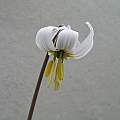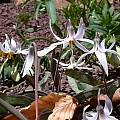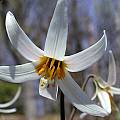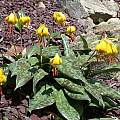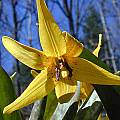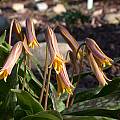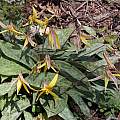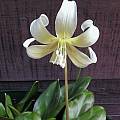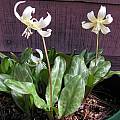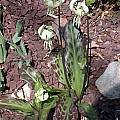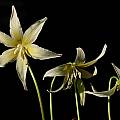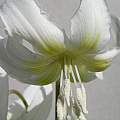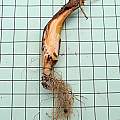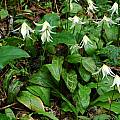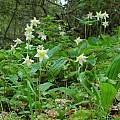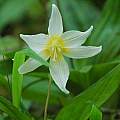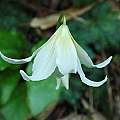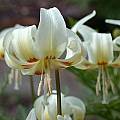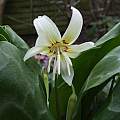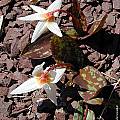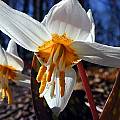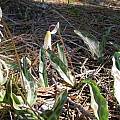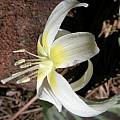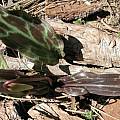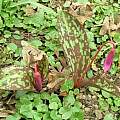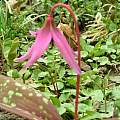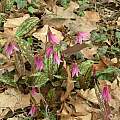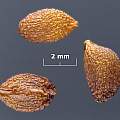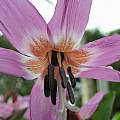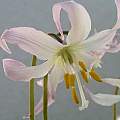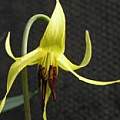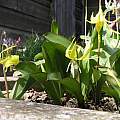Erythronium is a genus of about 20 species in the Liliaceae family. Most of the species are from Western North America but there are also a few in eastern North America and Eurasia. They are woodland or mountain meadow plants enjoying humus rich but well drained soil. They bloom in the spring. Erythronium species and cultivars a-g are found on this page.
Erythronium a-g - Erythronium h-o - Erythronium p-z - Erythronium index
Erythronium albidum Nuttall is native to the northeastern states where it grows in forest and scrub. It has small white flowers with a yellow throat and small light green leaves spotted reddish-brown and spreads by stolons. Height range: 10-30 cm. First photo by Ian Young. Remaining photos by John Lonsdale.
Erythronium americanum Ker-Gawler is found in moist woodland and on rocky wooded hillsides from southeastern Canada to Minnesota south to Texas. It has solitary flowers that are yellow flushed with brown, yellow inside with darker spots. The leaves are spotted in two shades of brown. It is stoloniferous. Height range: 10-20 cm. Photos by John Lonsdale.
Erythronium californicum Purdy grows in humus-rich soil in moist woodland in the Coast ranges of northern California. Grown from seed, the leaves at first were just green, but have become more mottled as the plants got older. Flowers are white with a greenish-yellow base marked by a ring of yellow, orange, or brown. Height range: 10-30 cm. The first three photos are by Mary Sue Ittner of plants blooming March 2004. The first picture shows a flower with a brown ring and the second one with a yellow ring (using plastic background to help the focus) and the third picture shows the pot with leaves and flowers. The fourth picture was taken by John Lonsdale and the fifth by Bob Werra. The last photo taken by Ian Young.
This photo taken by Mary Sue Ittner shows a bulb on a 1 cm grid.
Habitat pictures taken in Sonoma County, California, of populations growing on a wet bank alongside the road. Geophytic companions include Oxalis oregana, Scoliopus biglovii, Trillium ovatum, and Prosartes smithii, syn. Disporum smithii. Photos by Mary Sue Ittner.
Erythronium californicum 'White Beauty' is considered by some to be a white form of E. revolutum but others feel it is just a clone of E. californicum. (Comment: Dr. Geraldine Allen says 'White Beauty' is clearly a cultivar of E. californicum, perhaps with some hybridity in its ancestry.) It was introduced by Carl Purdy who selected it from his collections of bulbs he dug from the wild. This selection produces offsets more often than most of the plants in this species. Photos by John Lonsdale and Ian Young, respectively.
Erythronium caucasicum Woronow is from the Caspian region of Iran and has cream-colored flowers. Height range: 10-15 cm. Photos by John Lonsdale.
Erythronium citrinum S Watson is native to pine woods in the Siskiyou Mountains area of SW Oregon and NW California. Its leaves vary in the degree of mottling -- some are almost entirely dark. The cream yellow-centered flowers have auricles at the base of the petals, and an almost-unlobed stigma. Height range: 15-20 cm. First photo by Ian Young. Remaining photos of plants flowering in mid-March in the Illinois Valley of Oregon by Diane Whitehead. The pink of one flower may be from hybridization with E. hendersonii, although I saw none growing in the area.
Erythronium dens-canis L., the dogs-tooth violet, is a species of uncertain taxonomic delimitation, widely native across the Eurasiatic landmass. Several epithets are sometimes treated as subspecies of E. dens-canis and sometimes as distinct species. Kew lists 14 synonyms as well.
While bulbs purporting to belong to these taxa are available in the trade, it is not clear how accurate the naming is. Buyer beware! Height range: 10-35 cm. Photos 1-3 taken by Janos Agoston are typical. Photo 4 by David Pilling.
Photos below by Ian Young, the second photo showing a white form.
Erythronium elegans P.C.Hammond & K.L.Chambers, also known as the Coast range fawn lily or the elegant fawn lily, is endemic to Oregon in a few isolated locations along the Coastal range. In the wild it grows in poor soil where competition is low, yet performs well in cultivation. The Oregon Department of Agriculture put out the following PDF on the conservation of the species: Coast Range fawn lily (Erythronium elegans). Height range: to about 30 cm. Photo by Ian Young.
Erythronium grandiflorum Pursh is known as the yellow avalanche lily, or glacier lily. It is native to British Columbia south to California, with reports that it has been seen in Nevada and Arizona. It grows in subalpine meadows and flowers as the snow melts. Height range: up to 30 cm. Photos by Ian Young. The second photo shows Erythronium grandiflorum subsp. pallidum, a form with red edged leaves.
Erythronium a-g - Erythronium h-o - Erythronium p-z - Erythronium index
